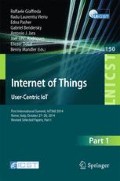Abstract
Cyber-Physical Systems are the next generation of embedded ICT systems, interconnected through the Internet of Things and endowed with data gathering functions and able to provide some output to users. Thanks to their features, if opportunely designed, they can affect user behavior on two levels: by means of the data gathered, promoting self-awareness to motivate change in the long term, and by means of direct physical cues, inviting users to perform some action in real time. The concept of affordance becomes crucial to the latter aspect: it is necessary to design novel, intuitive object affordances that foster a particular behavior.
Access this chapter
Tax calculation will be finalised at checkout
Purchases are for personal use only
References
Marcengo, A., Buriano, L., Geymonat, M.: Specch.io: a personal QS mirror for life patterns discovery and “Self” reshaping. In: Stephanidis, C., Antona, M. (eds.) UAHCI 2014, Part IV. LNCS, vol. 8516, pp. 215–226. Springer, Heidelberg (2014)
Bandura, A.: Social cognitive theory of self-regulation. Organ. Behav. Hum. Decis. Process. 50, 248–287 (1991)
Nakajima, T., Lehdonvirta, V., Tokunaga, E., Kimura, H.: Reflecting human behavior to motivate desirable lifestyle. In: Conference of Designing Interactive Systems, pp. 405–414 (2008)
Burke, L.E., Wang, J., Sevick, M.A.: Self-monitoring in weight loss: a systematic review of the literature. J. Am. Diet. Assoc. 111(1), 92–102 (2011)
Cadmus Bertram, L., Wang, J.B., Patterson, R.E., Newman, V.A., Parker, B.A., Pierce, J.P.: Web-based self monitoring for weight loss among overweight/obese women at increased risk for breast cancer: the HELP pilot study. PsychoOncology 22(8), 1821–1828 (2013)
Froehlich, J., Dillahunt, T., Klasnja, P., Mankoff, J., Consolvo, S., Harrison, B., Landay, J.: UbiGreen: investigating a mobile tool for tracking and supporting green transportation habits. In: Proceedings of the SIGCHI Conference on Human Factors in Computing Systems, pp. 1043–1052. ACM, New York, USA (2009)
Kay, M., Choe, E.K., Shepherd, J., Greenstein, B., Watson, N., Consolvo, S., Kientz, J.A.: Lullaby: a capture & access system for understanding the sleep environment. In: 2012 ACM Conference on Ubiquitous Computing, pp. 226–234. ACM, New York, USA (2012)
Gibson, J.: The theory of affordances. In: Shaw, R.E., Bransford, J. (eds.) Perceiving, Acting, and Knowing: Toward an Ecological Psychology, pp. 67–82. Lawrence Erlbaum Associates Inc, Hillsdale (1977)
Cipriani, F., Baldasseroni, A., Franks, S.: Combating a sedentary lifestyle and physical activity promotion. Line – Help. SNLG (2011)
Cooper, A.: About Face: The Essentials of User Interface Design. Hungry Minds Inc, New York (1995)
Carassa, A., Morganti, F., Tirassa, M.: Movement, action, and situation: presence in virtual environments. In: Raya, M.A., Solaz, B.R. (eds.) Proceedings of the 7th Annual International Workshop on Presence (Presence 2004 – Valencia, Spain, 13–15 October 2004), pp. 7–12 (2004)
Carassa, A., Morganti, F., Tirassa, M.: A situated cognition perspective on presence. In: Bara, B.G., Barsalou, L., Bucciarelli, M. (eds.) Proceedings of the 27th Annual Conference of the Cognitive Science Society (Stresa, Italy, 21–23 July 2005), pp. 384–389 (2005)
Tirassa, M., Bosco, F.M.: On the nature and role of intersubjectivity in human communication. Emerg. Commun. Stud. New Technol. Pract. Commun. 10, 81–95 (2008)
Jakobson, R.: Saggi di linguistica generale. Feltrinelli, Milano (1996)
Author information
Authors and Affiliations
Corresponding author
Editor information
Editors and Affiliations
Rights and permissions
Copyright information
© 2015 Institute for Computer Sciences, Social Informatics and Telecommunications Engineering
About this paper
Cite this paper
Cena, F., Rapp, A., Marcengo, A., Brizio, A., Hilviu, D., Tirassa, M. (2015). The Role of Affordance in Cyber-Physical Systems for Behavioral Change. In: Giaffreda, R., et al. Internet of Things. User-Centric IoT. IoT360 2014. Lecture Notes of the Institute for Computer Sciences, Social Informatics and Telecommunications Engineering, vol 150. Springer, Cham. https://doi.org/10.1007/978-3-319-19656-5_13
Download citation
DOI: https://doi.org/10.1007/978-3-319-19656-5_13
Published:
Publisher Name: Springer, Cham
Print ISBN: 978-3-319-19655-8
Online ISBN: 978-3-319-19656-5
eBook Packages: Computer ScienceComputer Science (R0)

